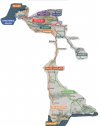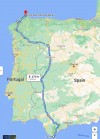Madrood
Active Member
- Time of past OR future Camino
- Estrecho (2023)
Hi all,
I started a thread in the Camino de Madrid sub-forum about whether to do that Camino or the CF, but after much helpful advice I've decided to restart the thread since I i) have a better idea of what I would like from a Camino now ii) think I didn't give other options enough consideration. I've listed some biographical information and aspirations below, along with where my thoughts are at for which Camino fits the description most. Once again, I would appreciate any and all advice you could give me, thanks in advance
Bio
Preferences
Caminos
Once again, thanks for all the advice you've previously contributed in general and on my previous thread, and for any suggestions you can give me.
Buen Camino 2022
I started a thread in the Camino de Madrid sub-forum about whether to do that Camino or the CF, but after much helpful advice I've decided to restart the thread since I i) have a better idea of what I would like from a Camino now ii) think I didn't give other options enough consideration. I've listed some biographical information and aspirations below, along with where my thoughts are at for which Camino fits the description most. Once again, I would appreciate any and all advice you could give me, thanks in advance
Bio
- 20something who walks 15-20 km about 2.5 out of 3 days.
- Semi-experienced hiker with a few >30km hikes in hilly and semi-mountainous terrain, mostly solo and often in winter. I usually load in my routes as .kml files into google maps and use the GPS on my phone to make sure I'm heading the right way.
- No experience of multi-day hikes, but I have gone interrailing before and planned and prebooked it, I'm comfortable with booking.com and enjoy planning ahead, though I haven't done that by phone before and being able to just show up would be nice.
- Not a Spanish speaker, but willing to learn what I can
- Coeliac, but not a foodie and happy to cook the basics most of the time
- Local airport flies to Malaga, otherwise takes a good chunk of a day to travel to the national airport for more options
- I plan on following an itinerary from here along with gronze, happy to do stages of any reasonable length.
Preferences
- A 1-2 month full Camino which finishes in Santiago; if possible, I'd also like to include the C-Ingles to A Coruna and/or C-Fenesterre.
- Starting in early to mid-march, +/- 2 weeks
- Budget of <€35 per day, but ideally <€25.
- Happy to stay in albergues, but being able to include unique accommodations (monasteries etc) would be a plus.
- Don't have a preference on social things, but I'm used to long solo hikes, and would prefer to avoid a scramble for accommodation
- Prefer dirt tracks and quiet countryside to pavement, minimal highway would be great
- Value geographical diversity, a mix of coast, mountains, forests, plains, whatever
- Value historical museums and buildings, particularly Roman, Carthaginian, and Medieval (Moorish and Christian, bonus points for Visigothic, bonus bonus points for anything to do with Ireland)
- Variation between cities and villages would be nice but not a deal breaker
- A balance point between a not-reckless adventure/test and appropriate first-timer journey
Caminos
- Camino Frances - This was strongly recommended to me in my first thread for a beginner, on the strength of it's infrastructure being conducive to my gluten-free requirements, the relative quietness of spring, and that Frances magic. There is also the option of switching to the Camino Primitivo if I want to switch to a road less traveled. I currently have it as my default option if I keep flip-flopping until it's time to lock in. My reservations for this route are i) it may still be quite busy due to the yearly increases in traffic, with the possibility of many who would have gone over the last 2 years having to defer until 2022 piling in ii) the very high amount of paving iii) the distance from Malaga iv) a vague idea that it's one of the more expensive ones v) a possibly misconceived idea that it would be coasting
- Camino Portuguese - I haven't considered this one too much on the basis that the section between Lisbon and Porto seems to have few albergues, and just going from Porto is a little short. But I think I may end up flying home from Porto (it's less of an issue flying home than flying in) so there is the option of doing this section in reverse, maybe following the Fatima route from Santiago.
- Via de la Plata - This one has the advantage of Seville being close to Malaga, with plenty of Roman architecture in Merida etc.. I have also read that this one is best in spring for the wildflowers, which suits me nicely. There is also the option of extending it downwards to Gibraltar (Via Serrara), also accessible from Malaga and I like the idea of the starting point being a long look across the sea to Africa, though I think there accommodation on this is touch and go. I have read elsewhere though that the albergues on this route can be expensive (?). From what I can see, the best parts seem to be in Extremadura, but this is mainly because of Merida and not knowing much about the Galician section. I've also heard that geographically it's pretty monotonous.
- Camino Mozarabe - There seems to be much variety here geographically and architecturally, with the most Moorish architecture along with the option to start directly from Malaga or the easily accessible Cordoba. But the albergue network seems to be a work in progress, which I'm guessing means that it would be relatively expensive up until it joins the VdlP. For that reason and others, I've seen many here discourage first-timers from it.
- Camino de Madrid - This was my first idea, since it seemed to have a good albergue network for a lightly traveled dirt path and was popular with those who have walked it. I figured that since this joins the Frances, I would be able to mix the two with the further option of the Primitivo for a nice mix. I could also prolong it my doing the VdlP as far as Caceres before transferring by train to Madrid (unless the second half of the VdlP was better ofc). There is also a recently found Irish connection, with the probable discovery last year of Red Hugh O'Donnell's remains in Valladolid. The downsides seem to be the possibility of a dangerous amount of snow around Segovia, as well as the isolation and lightly trafficked nature of the route being riskier for first-timers.
- Camino del Norte - This seems to be the most expensive route, and one of the least variable in geography (mostly mountains and coast). It also has the same distance from Malaga as the CF, and will probably be the most mucky in March. I have read elsewhere that the choice of albergues is curtailed outside of summer.
Once again, thanks for all the advice you've previously contributed in general and on my previous thread, and for any suggestions you can give me.
Buen Camino 2022


















